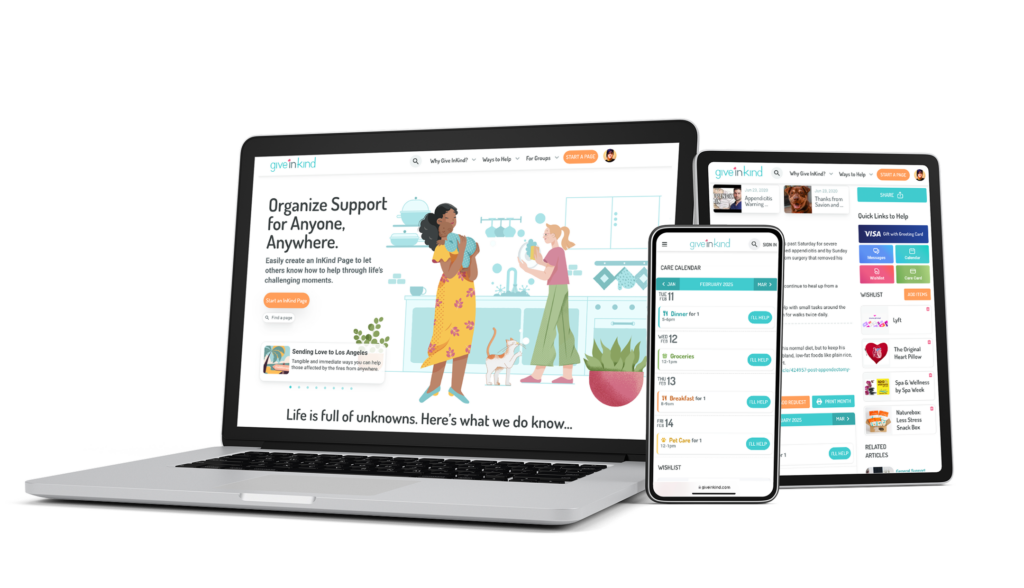Meal trains are a simple way to support families during tough times by organizing meal deliveries. Whether it’s after surgery, welcoming a new baby, or dealing with a loss, meal trains reduce stress and provide comfort. Here’s how to do it effectively:
- Use digital tools: Platforms like Give InKind simplify scheduling, dietary tracking, and volunteer coordination.
- Understand preferences: Collect details on allergies, meal types, and delivery instructions upfront.
- Plan a schedule: Deliver meals 3-4 times a week during set time slots to avoid overlaps.
- Ensure food safety: Use proper packaging, clear labels, and follow handling guidelines.
- Offer variety: Mix meal types, cuisines, and freezer-friendly options.
- Provide extra help: Add services like childcare, errands, or pet care.
- Keep volunteers engaged: Use group chats, updates, and thank-you messages to maintain motivation.
Meal trains are about more than food – they build a network of care. With thoughtful planning and tools, you can make a meaningful difference.
Tip 1: Set Up Digital Organization Tools
Digital tools can make coordination easier and reduce stress for both families in need and volunteers. One standout option is Give InKind, a platform designed to keep everything organized in one place.
Getting Started with Give InKind

Give InKind’s platform offers several helpful features for meal train coordination:
- Customizable scheduling: Set specific delivery times and include meal preferences.
- Privacy controls: Safeguard sensitive family details.
- Integrated wishlist: Families can list items they need.
- Direct donation options: Accept contributions via Venmo, CashApp, GoFundMe, or PayPal.
- Flexible gift cards: Manage gift cards in a centralized wallet.
These tools make it simple for users to manage meal trains effectively [1].
Using One Central Schedule
Having a single, shared schedule ensures smooth coordination and avoids confusion. Features like real-time updates, defined delivery windows, and a notes section help prevent duplicate deliveries and keep everyone informed [1].
Success hinges on all volunteers using and updating the same system. Automated email reminders further simplify communication, reducing the need for constant manual follow-ups by the organizer [1].
Whether you’re organizing meals for one family or multiple, a centralized platform helps keep everything on track [1].
Once your schedule is set, the next step is making sure the family’s specific needs are clearly communicated to all volunteers.
Tip 2: Collect and Share Family Food Preferences
Understanding a family’s specific food needs is key to organizing a meal train that’s genuinely helpful. By gathering this information early, you can avoid confusion and make things easier for everyone involved.
Gather Important Details
Use online tools to collect information such as:
- Dietary restrictions (e.g., allergies, gluten-free)
- Cultural preferences (like kosher or halal)
- Family size
- Preferred meal types (e.g., breakfast, dinner)
- Delivery instructions (e.g., best drop-off times)
Quick tip: Create one comprehensive questionnaire to collect all this information at once. This saves time and ensures privacy while avoiding repeated questions.
Share Information Clearly
Good communication is essential for keeping meal deliveries smooth. Here’s how to keep everyone on the same page:
- Set up a central location (like an online platform) where volunteers can access details like dietary needs, preferences, delivery instructions, and practical tips (e.g., reheating, labeling, or container guidelines).
- Update the platform regularly with any changes, such as adjustments to family size or new dietary restrictions, and inform volunteers promptly.
A clear system like this reduces issues like duplicate meals, missed deliveries, or meals that don’t fit the family’s needs. Once the requirements are sorted, you’re ready to move on to scheduling meal drop-offs efficiently.
Tip 3: Create a Workable Schedule
Planning a meal delivery schedule takes some thought, but it’s worth it to ensure smooth coordination for both the family receiving help and the volunteers providing meals. A solid schedule avoids missed deliveries or overlapping efforts.
Set Timeline and Meal Frequency
Decide how long the meal train will last and how often meals should be delivered. Here’s what to keep in mind:
- Family size: Bigger families may need more frequent deliveries or larger portions.
- Duration of need: Match the schedule to how long the family might need support.
- Storage space: Check if the family has enough room in their fridge or freezer.
Helpful tip: Delivering meals 3-4 times a week often strikes the right balance between providing support and avoiding storage issues.
Set Delivery Windows
Establishing clear delivery time slots helps everyone stay on the same page. Consider these common options:
| Time of Day | Hours |
|---|---|
| Morning | 9-11 AM |
| Afternoon | 2-4 PM |
| Evening | 5-7 PM |
Morning deliveries work well for breakfast or lunch prep, while evening slots are ideal for ready-to-eat dinners.
To make this work:
- Coordinate delivery times with the family’s routine and volunteers’ availability (e.g., evenings might suit working volunteers).
- Stick to 2-hour windows to keep things stress-free.
Digital tools can simplify scheduling. Platforms like Give InKind even send automatic reminders to volunteers.
With your schedule ready, the next focus is on ensuring meals are prepared and delivered safely.
Tip 4: Follow Food Safety Rules
Keeping food safe is a key part of supporting families in need. Proper handling and labeling help prevent foodborne illnesses and ensure meals are safe to enjoy.
Safe Food Handling Steps
Follow these steps when preparing and delivering meals:
| Stage | Guidelines |
|---|---|
| Preparation | Keep everything clean and avoid cross-contamination (e.g., wash hands, separate raw meats). |
| Packaging | Use leak-proof containers and pack hot and cold items separately. Add ice packs if needed. |
| Transport | Deliver meals within 30 minutes using insulated bags to keep food at the right temperature. |
The USDA’s Food Safety and Inspection Service suggests using digital thermometers to check food temperatures before packaging. Hot foods should stay above 140°F (60°C), and cold foods must stay below 40°F (4°C) during delivery.
Label Meals Clearly
Clear labeling makes meals safer and easier to use while meeting dietary needs. Each container should include:
- A list of ingredients and any dietary information (e.g., allergens, gluten-free).
- The date the meal was prepared.
- Storage and reheating instructions.
Consider using color-coded labels – like green for vegetarian meals or red for allergen alerts – to make identification quick and simple.
Once food safety is taken care of, you can focus on offering a variety of meal options to keep things interesting and helpful.
sbb-itb-413a223
Tip 5: Mix Up Meal Types
After ensuring food safety, the next step is to focus on creating a variety of meals. Offering different types of dishes keeps things interesting and ensures the family gets balanced nutrition during tough times.
Plan a Range of Meal Options
Include a mix of comfort foods, lighter meals, kid-friendly dishes, and recipes that can be prepared ahead of time. You can even introduce fun themes like “Taco Tuesday" to make planning easier and keep things fresh. Don’t forget to plan for both lunch and dinner, as families often need help with more than one meal each day.
Use Give InKind to Stay Organized
Ask volunteers to log their planned meals in advance to avoid duplicates and maintain variety. The Give InKind Care Calendar is a great tool for tracking meal details like types, portions, and delivery schedules.
When organizing meals, be mindful of:
- A balance between different cuisines
- A mix of fresh meals and freezer-friendly options
- Portions that match the family size
- Any dietary restrictions or special needs
This organized approach keeps meals interesting while ensuring the family gets the nutrition they need during a challenging time.
Once the meal plan is in place, think about other ways to provide support and ease their load even further.
Tip 6: Add Extra Help Options
Meal delivery is a great start, but families often need help with other daily tasks. Offering additional support can make a big difference in easing their overall stress.
Offer Help Beyond Meals
Think about organizing help for tasks like light cleaning, babysitting, pet care, or running errands (like grocery shopping or picking up prescriptions). Tools like Give InKind make it easy to manage these tasks alongside meal deliveries, keeping everything organized in one place.
Plan and Schedule Services
When setting up these extra services, use the same structured approach as you would for meal delivery:
| Service Type | Scheduling Tips | Important Details |
|---|---|---|
| Childcare | Plan 2-3 weeks ahead | Include emergency contacts and allergy info |
| Pet Care | Set consistent walking times | Provide feeding instructions |
| Errands | Sync with medical appointments | Save and share receipts |
To keep everything running smoothly:
- Assign one coordinator to manage updates and communication. This avoids overwhelming the family with too many messages.
- Set clear time slots for each service to ensure reliability.
- Document preferences or instructions for each task to avoid confusion.
Families dealing with tough situations often feel overwhelmed by too many choices. Instead of asking open-ended questions like “What do you need?", structured offers of specific help can be more effective. Using Give InKind’s Care Calendar, volunteers can sign up for tasks easily, keeping everything simple and organized.
Tip 7: Keep Volunteers Connected
Building a strong volunteer network is essential for running a successful meal train. A well-connected group ensures consistent support for the family and creates a shared sense of purpose among everyone involved.
Expand Your Volunteer Network
To grow your volunteer base, focus on outreach and smart organization. Here are some effective methods:
| Outreach Method | Best Practices | Expected Impact |
|---|---|---|
| Social Media | Post weekly updates with specific needs | Reaches 3-4x more potential volunteers |
| Community Groups | Partner with local organizations or faith groups | Adds 5-10 reliable helpers per group |
| Digital Platforms | Use scheduling and communication tools | Simplifies coordination and planning |
Platforms like WhatsApp or Facebook can help streamline communication and foster a sense of community. Once your network is up and running, keeping volunteers engaged and appreciated is vital for long-term success.
When posting Updates on Give InKind, you can simultaneously share the information to all of your page followers and supporters, as well as Facebook and Twitter. Eliminate duplicate efforts and keep everyone on the same page.
Show Appreciation to Volunteers
Recognizing your volunteers’ efforts keeps them motivated and committed. Studies show that gratitude plays a big role in maintaining participation over time.
Here are some easy ways to show your thanks:
- Send personalized thank-you messages within 24 hours of a meal delivery. If the family is comfortable, share updates to highlight the impact of their help.
- Utilize a shared space, like a social media post, or the Messages area of your InKind Page, to celebrate contributions and showcase the group’s collective efforts.
- Host monthly virtual meetups where volunteers can connect, share stories, and feel part of the bigger picture.
“Clear communication, recognition, and a sense of purpose are key to maintaining volunteer engagement", says Curtis del Principe, senior marketing manager at HubSpot [5].
For longer-term meal trains, consider organizing quarterly appreciation events. These in-person gatherings give everyone a chance to connect and celebrate the positive difference they’ve made together.
Conclusion: Making Meal Trains Work Better
Organizing meal trains effectively takes careful planning and the right tools to truly support families during tough times. Digital platforms have transformed the way we coordinate these efforts, simplifying tasks like managing schedules, tracking dietary preferences, and staying in touch with volunteers.
When technology meets human connection, meal trains can make a bigger difference. For example, digital tools can extend support periods from just a few weeks to up to 12 weeks and increase volunteer participation by 60% [3]. This combination ensures smooth coordination while fostering genuine community involvement.
The best meal trains bring together scheduling, communication, and resource management into one system. This approach can ease family stress levels by up to 40% during crises [4]. By blending thoughtful planning with digital solutions, communities can build networks of care that go beyond simply delivering meals.
These tools have streamlined the process, saving hours of coordination while keeping the heartfelt, personal aspect of meal trains intact. They allow organizers to focus on what matters most – supporting families when they need it most.
Meal trains are about more than just providing food. They’re about building a support system that helps families navigate difficult times. With good organization and the right digital tools, these systems can run smoothly while keeping the personal connection that makes them so meaningful.
FAQs
What is the best way to organize a meal train?
Platforms like Give InKind make organizing meal trains much easier. These tools help you manage schedules, coordinate volunteers, and keep communication clear. To ensure success:
- Plan a variety of well-rounded meals.
- Track meal details to avoid duplicates.
- Include store-bought options when needed.
- Build a dependable group of volunteers.
- Keep communication consistent.
Using these platforms ensures smooth coordination and helps everyone stay on the same page throughout the process [1].
How to start a dinner train?
Starting a dinner train is simple if you follow these steps:
- Pick a digital platform like Give InKind to set up a support page with a shared calendar.
- Share the meal train link through:
- Email lists
- Social media groups
- Community forums
- Local organizations
Combining good organization with community involvement is the key to a successful dinner train, as highlighted in earlier tips [1].
Helpful Products
Give InKind does not provide medical advice, diagnosis, or treatment. We have an affiliate relationship with many of the advertisers on our site, and may receive a commission from any products purchased from links in this article. See Terms & Conditions.




